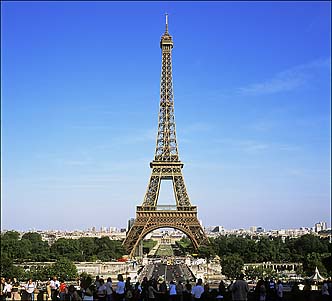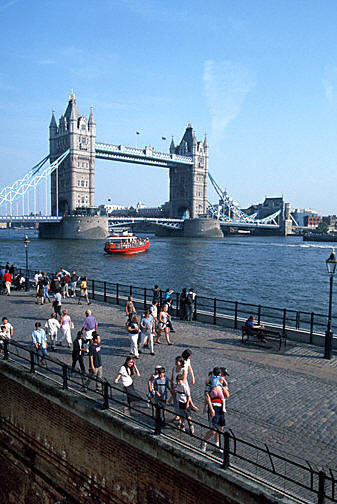
This is the Eiffel Tower, the most widely recognized national landmark in the world.
The Eiffel Tower is a 320-metre tower built of structural iron, originally constructed by engineer Gustave Eiffel (after whom the tower is named) for an international exposition in Paris in 1889. The tower was the only structure in the exposition intended for permanent display, and it survives to this day intact. It narrowly escaped demolition and conversion to scrap on several occasions in its youth, but today nobody would think of tearing down the Eiffel Tower.
This picture was taken from the parvis du Trocadéro, a plaza between the two wings of the Palais de Chaillot; most of the plaza is closed for repairs, but enough of it is open to allow people to circulate and enjoy the view, and there is a small, elevated wooden passageway over the part of the plaza undergoing repairs that offers an excellent view. This picture was taken from that point, which is about 500 metres away from the tower, on the opposite (right) bank of the Seine River. The river flows directly in front of the tower under the Iéna Bridge, and you can see the bridge (but not the water) in the lower foreground of this photo. Behind the tower, you can see the Champ de Mars, a medium-sized park, with the École Militaire (a military school) at the other end. In this photograph, you are looking southeast. The sun is to your right, above and behind you. The picture was taken at about 6:00 PM, about 3.5 hours before sunset on this June afternoon.
There are elevators in the tower that can take you to the top. Double-decked elevators to the first and second levels are specially designed to ascend along the steep incline of the tower’s legs. More conventional double-decked glass elevators take you from the second level up to the summit (one of these is just barely visible here—look for the tiny trace of a red object just below the summit). Since the tower is build of open ironwork, the ascent can be a very harrowing experience for anyone with a fear of heights, so beware!
Incidentally, the tower is much larger than it appears to be in photographs; the absence of anything of comparable height nearby makes it difficult to appreciate the tower’s height in pictures. The trees on either site of the tower are seven or eight stories high, and more than two American-style football fields would fit comfortably in the area covered by the tower’s base. Individual people are almost too small to distinguish in this photo, even in the large version, but you can see little ant-like figures near the base of the tower and on the bridge.
The scaffolding that is just barely visible beneath the tower on the northeast (left) side is there to allow some renovation work on the decorative arch beneath the first platform. The tower was also being repainted at the time of this photograph, although that is not really apparent to the observer.
For those of you who are wondering, the replica of the Eiffel Tower at Paris Las Vegas is half the size of the real thing (that is, 50 stories tall for the replica, and 100 stories for the real tower).

The Tower Bridge's image is synonymous with London. Other than Big Ben, the bridge is probably the most recognizable attraction in London. It is certainly the most decorative and spectacular bridge spanning the Thames and is also a functioning drawbridge. It was painted blue in honor of Queen Victoria's favorite color.
Construction of the Tower Bridge lasted from 1886-1894 and the final cost exceeded £1,500,000. The hydraulic twin bastules weigh 1,000 tons each. They are lifted when necessary to allow ships entry to the Pool of London, the area of the Thames River between this, the most easterly of the London bridges, and London Bridge. The former pedestrian walkway spanning between the two towers of the bridge is a breathtaking 112 feet above the surface of the Thames River.
The Tower Bridge is now a museum. It can be toured for a modest fee. It is well worth the admission price, however, to get the unobstructed view of the the city and Thames River that is afforded from the old pedestrian walkway.